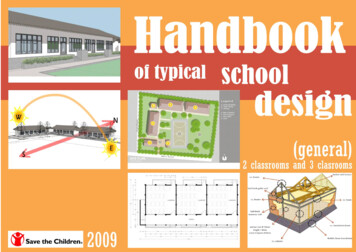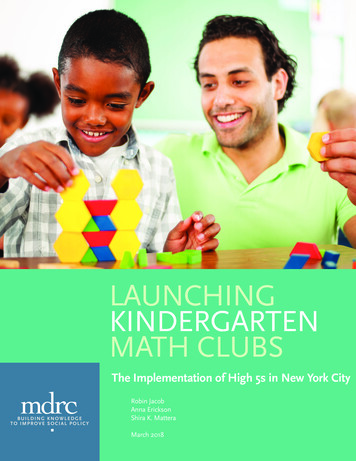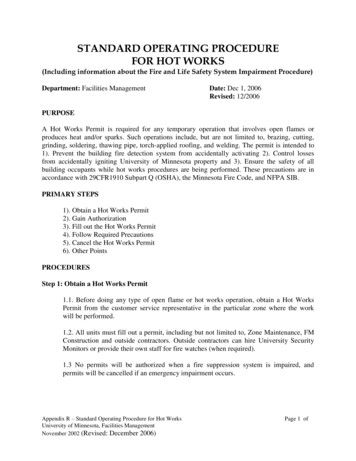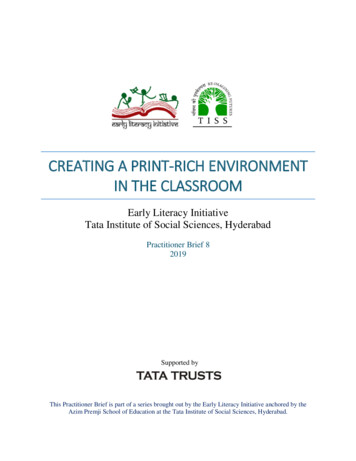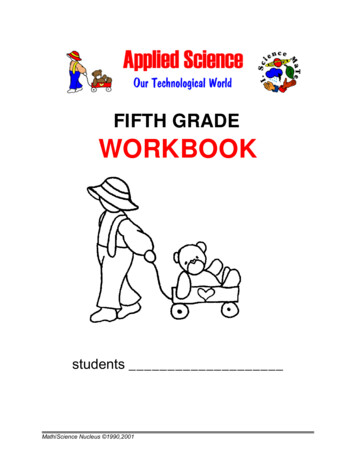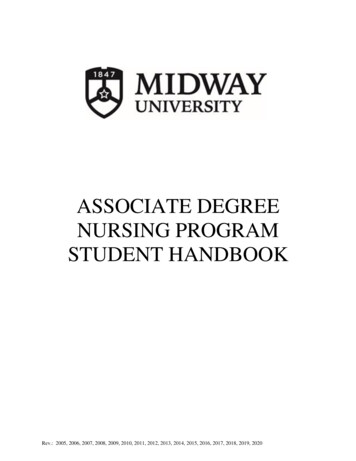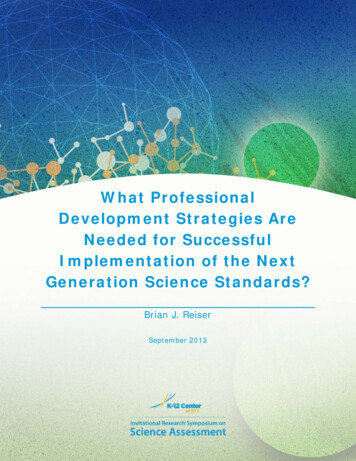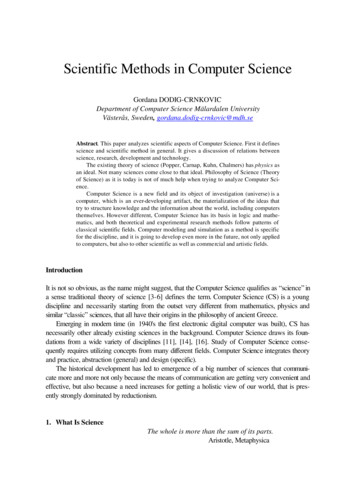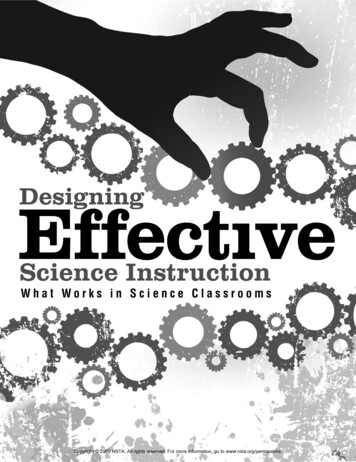
Transcription
What Works in Science ClassroomsCopyright 2009 NSTA. All rights reserved. For more information, go to www.nsta.org/permissions.
Copyright 2009 NSTA. All rights reserved. For more information, go to www.nsta.org/permissions.
W h a t Wo r k s in S c ie n c e C la ss ro o msAnne TweedArlington, VirginiaCopyright 2009 NSTA. All rights reserved. For more information, go to www.nsta.org/permissions.
Claire Reinburg, DirectorJennifer Horak, Managing EditorAndrew Cocke, Senior EditorJudy Cusick, Senior EditorWendy Rubin, Associate EditorArt and DesignWill Thomas Jr., DirectorJoseph Butera, Senior Graphic Designer, cover and interior designCover illustration courtesy of iStock, photocanal25Printing and ProductionCatherine Lorrain, DirectorJack Parker, Electronic Prepress TechnicianNational Science Teachers AssociationFrancis Q. Eberle, PhD, Executive DirectorDavid Beacom, PublisherCopyright 2009 by the National Science Teachers Association.All rights reserved. Printed in the United States of America.12 11 10 094 3 2 1Library of Congress Cataloging-in-Publication DataTweed, Anne.Designing effective science instruction: what works in science classrooms / by Anne Tweed.p. cm.Includes bibliographical references and index.ISBN 978-1-935155-06-51. Science--Study and teaching. 2. Curriculum planning. I. Title.Q181.T87 2010507.1--dc222009028415eISBN 978-1-936137-95-4NSTA is committed to publishing material that promotes the best in inquiry-based science education. However, conditionsof actual use may vary, and the safety procedures and practices described in this book are intended to serve only as a guide.Additional precautionary measures may be required. NSTA and the authors do not warrant or represent that the proceduresand practices in this book meet any safety code or standard of federal, state, or local regulations. NSTA and the authorsdisclaim any liability for personal injury or damage to property arising out of or relating to the use of this book, includingany of the recommendations, instructions, or materials contained therein.PermissionsYou may photocopy, print, or e-mail up to five copies of an NSTA book chapter for personal use only; this doesnot include display or promotional use. Elementary, middle, and high school teachers only may reproduce asingle NSTA book chapter for classroom or noncommercial, professional-development use only. For permissionto photocopy or use material electronically from this NSTA Press book, please contact the Copyright ClearanceCenter (CCC) (www.copyright.com; 978-750-8400). Please access www.nsta.org/permissions for further informationabout NSTA’s rights and permissions policies.Mid-continent Research for Education and Learning (McREL) is a nonprofit education R&D organization(www.mcrel.org) that offers staff development and consulting services to school districts nationwide, includingworkshops and other professional support for Designing Effective Science Instruction. To learn more, e-mail McRELat info@mcrel.org/desi or call 1-800-781-0156.Copyright 2009 NSTA. All rights reserved. For more information, go to www.nsta.org/permissions.
DedicationThis book is dedicated to my parents, Irvin and Jeanette Leerssen. Their hard work,dedication to family, and love of the outdoors has provided me with the inspiration andoptimism to pursue science, continue as a learner, and strive to help others. From them Ihave learned that with planning and preparation, positive results are always possible!Copyright 2009 NSTA. All rights reserved. For more information, go to www.nsta.org/permissions.
Copyright 2009 NSTA. All rights reserved. For more information, go to www.nsta.org/permissions.
ContentsForeword. ixAcknowledgments. xiAbout the Author.xiiiIntroduction. xvChapter1 Building the Framework. 1Chapter2 Content. 23Strategy 1: Identifying “Big Ideas” and Key Concepts. . 24Strategy 2: Unburdening the Curriculum. 38Strategy 3: Engaging Students With Content. . 46Strategy 4: Identifying Preconceptions and Prior Knowledge. 51Strategy 5: Assessment—How Do You Know That They Learned?. . 59Strategy 6: Sequencing the Learning Targets Into a Progression. 69Chapter3 Understanding. 77Strategy 1: Engaging Students in Science Inquiry. 77Strategy 2: Implementing Formative Assessments. . 88Strategy 3: Addressing Preconceptions and Prior Knowledge. .100Strategy 4: Providing Wrap-Up and Sense-Making Opportunities. .107Strategy 5: Planning for Collaborative Science Discourse.112Strategy 6: Providing Opportunities for Practice, Review, and Revision.120Chapter4 Environment.127Strategy 1: Believe All Students Can Learn. .127Strategy 2: Think Scientifically.138Strategy 3: Develop Positive Attitudes and Motivation.150Strategy 4: Provide Feedback.161Strategy 5: Reinforcing Progress and Effort.168Strategy 6: Teach Students to Be Metacognitive.177Chapter5 Teacher Learning: A Beginning.187References.191Appendixes.203Chapter 1 Appendixes.203Chapter 2 Appendixes.204Chapter 3 Appendix.210Chapter 4 Appendixes.211Index.217Copyright 2009 NSTA. All rights reserved. For more information, go to www.nsta.org/permissions.
Copyright 2009 NSTA. All rights reserved. For more information, go to www.nsta.org/permissions.
ForewordScience teachers everywhere agree: Teaching science, no matter the level, is hardwork! To do it well and to be effective requires continuous learning. Not onlyis the knowledge base that explains science phenomena continuing to increase,research findings that help us understand how students learn are also increasing.The goal for science teachers is to maintain a balance so that it is not about workingharder trying to keep up with the new research-based findings, but about workingtogether to implement the best practices in the classroom.Designing Effective Science Instruction: What Works in Science Classrooms isdesigned to pull together recent findings from many science education studiesand teacher education initiatives. It can be a daunting task for a teacher to learnabout each initiative separately and then integrate the new learning within existinginstructional frameworks, one initiative at a time. This book presents an instructional framework and includes the separate initiatives (i.e., addressing misconceptions, formative assessments, inquiry approaches) as part of a larger framework ofeffective science instruction. An individual teacher of science or groups of teacherscan use Designing Effective Science Instruction to plan and implement changes to hisor her science instruction.Effective Science Instruction: What Does Research Tell Us? (Banilower et al. 2008)summarizes the research foundation for this book. In this report, researchers shedlight on possible reasons for poor student performance in science. Most notably,research revealed that in a national sample of science classrooms, science lessonsdo not often include the features identified as part of effective science instruction.In other words, too many science students are not clear about the learning goalbeing taught, and they are not being asked to make sense of the content that theteachers deliver. Students cannot, because of this classroom culture and instruction, understand and retain the science concepts they are supposedly learning.If the students are learning, the learning is frequently temporary and often as aresponse to a quiz or test. The study further indicated that teachers of science aretoo often unaware of the research that identifies the effective practices they needto implement in their science classrooms.Designing Effective Science InstructionCopyright 2009 NSTA. All rights reserved. For more information, go to www.nsta.org/permissions.ix
For the past several years I have worked with teachers of science as theydesigned and redesigned their lesson plans, examined their craft, and attemptedto implement change in their classrooms. The result was often ineffective, withlittle or no change to the science teachers’ overall practice. The reason for this lackof change was simple: Limited information was available to me about effectiveteaching and I had to turn to a myriad of research articles that had little impacton the teachers themselves. This book will change all that by bridging the gapbetween research and practice.The book begins by providing examples of effective strategies that support thedevelopment and delivery of science lessons that foster student understanding ofthe science concepts being taught. It targets one key element found in the (Weisset al. 2003) research into designing effective lesson plans. The book dives into thecharacteristics of effective lesson plans, asks teachers to reflect on their currentlessons, and then provides strategies for redesigning those lesson plans into evenmore effective lessons—ones that embody the characteristics of high-quality lessons from the research.Using the Content-Understanding-Environment (C-U-E) method, this bookgives teachers the tools to approach lesson planning with confidence. Teachers willbe able to pinpoint aspects of their instructional practice that need improvement.They will understand how to seek out the content knowledge and experiencesthey need to become more effective science teachers. They will be able to implement changes to their teaching craft, to become effective facilitators of studentlearning, and to provide their students with rich and active learning environmentsthat allow for successful student achievement.I know teachers of science will find this book helpful, valuable, and informative. The book will assist as they evaluate science instructional practices, reflect onthat practice, and make changes to improve that practice—the hallmarks of beingeffective science teachers. Designing Effective Science Instruction embodies this. Letthe journey begin.—Shelley LeeReferencesBanilower, E., K. Cohen, J. Pasley, and I. Weiss. 2008. Effective science instruction:What does research tell us? Portsmouth, NH: RMC Research Corporation, Centeron Instruction.Weiss, I., J. Pasley, S. Smith, E. Banilower, and D. Heck. 2003. Looking inside theclassroom: A study of K–12 mathematics and science education in the United States.Chapel Hill, NC: Horizon Research, Inc.xNational Science Teachers AssociationCopyright 2009 NSTA. All rights reserved. For more information, go to www.nsta.org/permissions.
AcknowledgmentsAnne Tweed, principal consultant, would like to thank the following individuals for their support and assistance with the Designing Effective Science Instruction:What Works in Science Classrooms book.Special thanks to Jan Tuomi, who was a major contributor to the instructional framework, and to Judy Counley, who created the figures and tables forthis book.Thanks to McREL staff: Sarah LaBounty, who contributed writing support;Heather Hein, writer/editor; Sue Amosun, administrative coordinator; LindaBrannan, director of information services; and special thanks to Lisa Maxfield,administrative coordinator.Thanks also to Ceri Dean for her editing and overall project support. And afinal thank you to Laura Arndt, Jean May-Brett, Shelley Lee, and Susan Koba, all ofwhom are longtime friends and professional colleagues. Their continuous supportfor this project has been invaluable.Some of the original work upon which this publication is based was sponsored, wholly or in part, with funds from the U.S. Department of Education Officeof Elementary and Secondary Education (OESE); Eisenhower Regional Mathematics and Science Education Consortia, under grant R319A000004; and the Instituteof Education Sciences (IES), under Contract No. ED-01-CO-0006. The content doesnot necessarily reflect the position or policy of OESE, IES, the Department of Education, or any other agency of the federal government.Designing Effective Science InstructionCopyright 2009 NSTA. All rights reserved. For more information, go to www.nsta.org/permissions.xi
Copyright 2009 NSTA. All rights reserved. For more information, go to www.nsta.org/permissions.
About the AuthorAnne Tweed, a principal consultant with the Mid-continent Research for Education and Learning (McREL) in Denver, Colorado, also serves as the director ofthe North Central Comprehensive Center. Her work at McREL supports professional development in the areas of effective science instruction, inquiry-basedinstruction, formative assessment, high-quality instructional practices, teachingreading in content areas, analyzing instructional materials, and audits of science curricula and programs. The work is research based and includes ongoingprofessional development workshops. In her role as director of the North Central Comprehensive Center, she leads project activities that build the capacityof state education agencies through resource dissemination, group facilitation,building infrastructure and networking, planning and needs assessment, developing solutions that are part of statewide systems of support, and revising toolsand templates that support schools in need of improvement. She is currently aco–principal investigator on an NSF DRK-12 project that supports implementation of nanoscale science and technology in secondary classrooms.Tweed is a past president of the National Science Teachers Association (2004–2005). A veteran high school science educator and department coordinator, shespent the majority of her 30-year teaching career with the Cherry Creek SchoolDistrict in Colorado. Tweed earned an M.S. in botany from the University of Minnesota, a B.A. in biology from Colorado College, and a teaching certificate fromthe University of Colorado. Tweed has held several leadership positions withNSTA, the Colorado Association of Science Teachers, and the Colorado Alliancefor Science. She was on the review committee for the National Science EducationStandards and a contributor to the original Colorado Model Content Standardsfor Science. In addition, Tweed served on the program planning team revisingthe 2009 NAEP Framework for Science. Tweed has been recognized for her workin education and has received the Distinguished Service Award and the Distinguished High School Science Teaching Award from NSTA, the Outstanding Biology Teacher Award for Colorado, and is a state Presidential Award honoree. Shehas published many articles, coauthored several books, given more than 150 presentations and workshops at state and national conferences, and continues to beactive with state and national science associations.Designing Effective Science InstructionCopyright 2009 NSTA. All rights reserved. For more information, go to www.nsta.org/permissions.xiii
Copyright 2009 NSTA. All rights reserved. For more information, go to www.nsta.org/permissions.
IntroductionWhy This? Why Now?Science teachers, like all teachers, start each school year with high hopes and expectations for students to succeed. They plan their lessons, scramble to get the necessary equipment, and work hard to engage their students. However, despite goodintentions and best-laid plans, not all students do well in science classes, and evenfewer achieve mastery. We see the effects of this all around us. Student performanceon national and international assessments, including science assessments, is poor.More and more adults are unable to understand the scientific issues that affecttheir lives and society. The media reports that national economic competitivenessis at stake. It’s clear that something must be done now to help science teachers putpower behind their hopes and expectations for student achievement.Designing Effective Science Instruction: What Works in Science Classrooms ismeant to help teachers focus on what can and must be done. It draws upon recentresearch in science education, most notably a well-designed study of science classrooms which sheds light on possible reasons for poor student performance in science (Weiss et al. 2003; Banilower et al. 2008). This research study and subsequentreport on effective science instruction revealed that in a national sample of scienceclassrooms, about two-thirds of science lessons observed were of low quality. Inother words, too many science students sit passively, never being asked to makesense of the content that teachers deliver. Too many science activities masqueradeas science lessons and fail to develop students’ understanding of science concepts.Too many teachers lower their expectations and avoid teaching a rigorous science curriculum. The pressure teachers feel to meet student achievement goals isimmense. With emerging research findings about how students learn and how toteach effectively, guidance for teachers is available.The Weiss et al. study also tells us that teachers often are unaware that researchhas identified teacher knowledge and skills that support the development anddelivery of science lessons that foster student learning. This and other researchDesigning Effective Science InstructionCopyright 2009 NSTA. All rights reserved. For more information, go to www.nsta.org/permissions.xv
iIntroductionon teaching and learning lead us to believe that designing high-quality sciencelessons that include research-based instructional practices is a logical first stepto improving all students’ science learning. As a result, Designing Effective ScienceInstruction focuses on strategies that science teachers at all levels can use to maketheir science lessons better.Educational research on learning and effective science instruction has much tooffer us in meeting the challenges of educating students to high standards. Whatis missing in previous books on effective science lessons and instruction is a synthesis of the research that focuses on the essential findings and the implications forinstructional practice. Designing Effective Science Instruction provides that bridgebetween research and practice, and does so in a format that is easy to learn, use,and continue to apply.This book will describe the characteristics of high-quality science lessons, helpyou reflect on what is working well with your current approach to designing lessons, and provide recommendations for improving existing lessons or creatingeffective new ones. Whether you are a novice or veteran teacher, the self assessments and recommendations in this book will provide guidance that supports andencourages you to refine what you do to become a more effective science teacher.You can use this book to decide what practices will work for you and your students, but you are encouraged to work with others as you plan for and reviseinstruction, interpret student work, and determine what changes you will maketo your teacher practices. Planning for your own professional development is oneway to use the information contained in this book. Many resources are available tohelp you plan for meaningful professional development that is ongoing and usesa model that features reflective practice in the real world of teachers. The NationalScience Education Standards (NRC 1996) for teaching and professional development provide a starting point and helped to inform this book.No matter what grade level you teach, you will benefit from learning the Content-Understanding-Environment (C-U-E) instructional framework described inthis book. We believe that if you understand and apply this framework, you willbe able to approach lesson planning with confidence and develop well-planned,effective science lessons. In addition, you will be able to pinpoint aspects of yourinstructional practice that need improvement and seek out the content knowledgeand experiences that will be most helpful in making you a more effective teacher.Together these will lead to positive teacher and student attitudes toward sciencelearning and positive science achievement results for all students.xviNational Science Teachers AssociationCopyright 2009 NSTA. All rights reserved. For more information, go to www.nsta.org/permissions.
IntroductioniOrganization of DesigningEffective Science Instruction bookDesigning Effective Science Instruction: What Works in Science Classrooms (DESI) isorganized into five chapters. The next four chapters introduce the C-U-E instructional framework and provide details about each of its three elements (Content,Understanding, Environment). The contents of chapters 2 through 5 are describedbriefly below.Chapter 1. Building the Framework. This chapter focuses readers on the followingquestions as the three components of the C-U-E framework are introduced: Effective science teaching: What does it mean and how does it look? What are the barriers to effective instruction? What does research say about effective science instruction? Why the Content-Understanding-Environment framework?This chapter emphasizes that all three elements must be addressed during lessondesign and implemented effectively when delivering science instruction.Chapter 2. Identifying Important Content. This chapter focuses on identifying important content, clarifying student learning goals, sequencing learningactivities to achieve those goals, and aligning assessments with content. Thisnecessitates thinking about ways to prune the curriculum and determine studentprior knowledge and preconceptions.Chapter 3. Developing Student Understanding. Using the research on howstudents learn science, this chapter will help readers learn how to make lessonslearner-centered, help students make meaning and build connections amongscience concepts, and develop each student’s ability to learn. To support sensemaking, we include strategies that address misconceptions, that make studentthinking visible with classroom discourse and that encourage formative assessment processes to identify student learning and provide feedback.Chapter 4. Creating a Learning Environment. Interactions, routines, andinformal feedback that occur every day in the classroom can undermine or enhancelearning. This chapter presents strategies related to teaching students to takeresponsibility for their thinking and learning and to developing positive workingrelationships with others. Student engagement and motivation are critical components of collaborative classroom environments, and strategies that address thesecomponents are included in this chapter also.Designing Effective Science InstructionCopyright 2009 NSTA. All rights reserved. For more information, go to www.nsta.org/permissions.xvii
iIntroductionChapter 5. Teacher Learning: A Beginning Teachers continue to learn throughout their lifetimes. All teachers can learn just as all students can learn. To movefrom “surviving to thriving” we need to look at how the instructional frameworkapplies to us. The key to this work is establishing an environment for ourselvesthat promotes learning—learning and thinking about the content we teach, learning about content-specific strategies that move students’ thinking forward, andlearning how to keep a balance but still move forward.The Audience for Designing EffectiveScience InstructionFirst and foremost, this book is valuable for science teachers, both veteran andnovice, at all grade levels. It is also of value to anyone concerned with improving science education and nurturing effective science teaching. This latter groupincludes principals and department heads, curriculum specialists, science mentors, professional development providers, and professors in schools of education.Different science professionals will use the information in this book differently,depending on their goals for improving science instruction.Teachers at different grade levels and with different levels of experience willfocus on different aspects of the book. This is not meant to be a prescriptive, onesize-fits-all book. All teachers will take away lessons that meet their individual needsand promote self-examination of their current instructional practices. For example,if you’re a veteran high school teacher, you probably have significant content knowledge; thus, you will benefit most by focusing on lesson design and developing student understanding. In doing so, the biggest change for you may be shifting from ateacher-centered classroom to a student-centered environment. All teachers, though,whether novices or veterans, will want to learn more about how to promote effectivescience instruction that focuses on important content, engages students in scienceinquiry, promotes student sense-making using science discourse, and involves students in formative assessments and student self-assessments so that both studentsand teachers will know if learning is taking place.Principals and department coordinators, who are responsible for ensuringthat science lessons are of high quality, can use the recommendations in this bookwhen analyzing curriculum, providing professional development for staff, andhelping teachers create a community of support for instructional change. Withoutsuch support from principals and department coordinators, even well-intentionedand highly qualified teachers may become discouraged and some may choose toleave the profession altogether.xviiiNational Science Teachers AssociationCopyright 2009 NSTA. All rights reserved. For more information, go to www.nsta.org/permissions.
IntroductioniOther professional development providers, too, can use the information inDesigning Effective Science Instruction: What Works in Science Classrooms to createprofessional development experiences that directly address the strategies in theframework or to help teachers develop a deeper understanding in each area of theframework. All professional development providers who use the research baseand proposed strategies in this book, whether principals, department coordinators, or teacher leaders, are responsible for creating the conditions for teachers’success—making the appropriate connections between professional developmentexperiences, helping them understand how all the pieces fit together, and providing them with opportunities to implement, then reflect on, new strategies as theydevelop a new repertoire of instructional practices.Last but not least, Designing Effective Science Lessons contains valuable information for prospective science teachers. This book could be used as part of a coursefor preservice teachers, laying the foundation for effective science instruction andhigh-quality lessons as they learn how to teach. The instructional framework andrecommended strategies could help preservice teachers set appropriate goals,envision effective science instruction, and learn how best to approach planningtheir lessons.How to Get Started With the BookThe first step to getting started with this book is to get familiar with the C-U-Eframework in Chapter 2. Because the C-U-E instructional framework representsa coherent whole, make sure to pay attention to all of its parts. Incorporating anyone of the strategies in lesson design will increase lesson effectiveness, but thisapproach will not be as effective as using the entire framework to design your lessons. At the same time, selecting one or two strategies to practice at a time to seehow they work can be a good approach initially. The strategies you choose as afocus will most likely relate to your biggest challenges. Your unique classroom andcommunity context will determine how you will get started. The key to rememberis that you will want to be able to answer the following three questions:1. What essential learning are you including in your lessons and unit of study?(Content—C)2. What learning experiences will you provide to develop student conceptualunderstanding? (Understanding—U)3. How will you and your students support a positive classroom environmentthat supports learning by all students? (Environment—E)Designing Effective Science InstructionCopyright 2009 NSTA. All rights reserved. For more information, go to www.nsta.org/permissions.xix
iIntroductionDependin
I know teachers of science will find this book helpful, valuable, and informa-tive. The book will assist as they evaluate science instructional practices, reflect on that practice, and make changes to improve that practice—the hallmarks of being effective science teachers. Designing Effectiv
